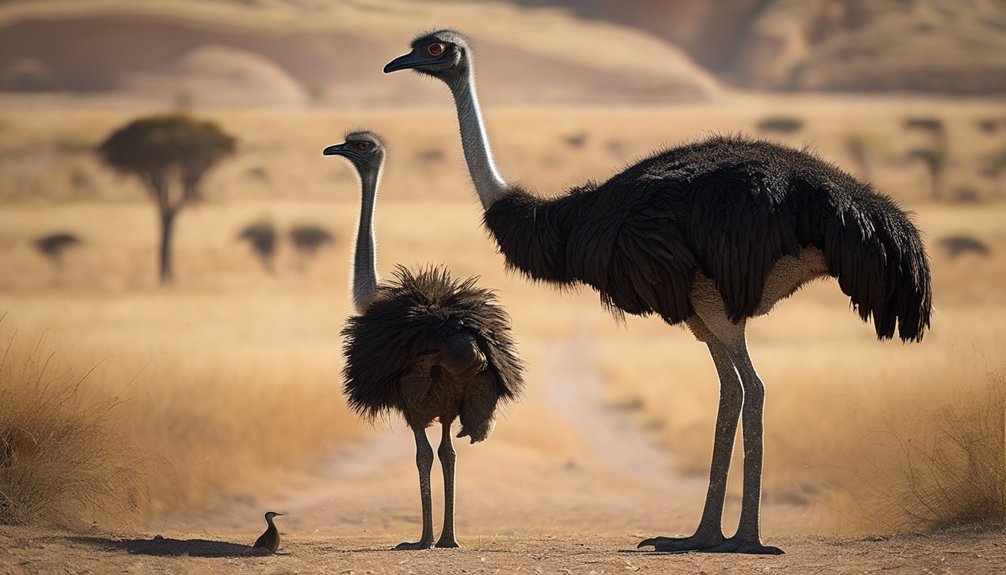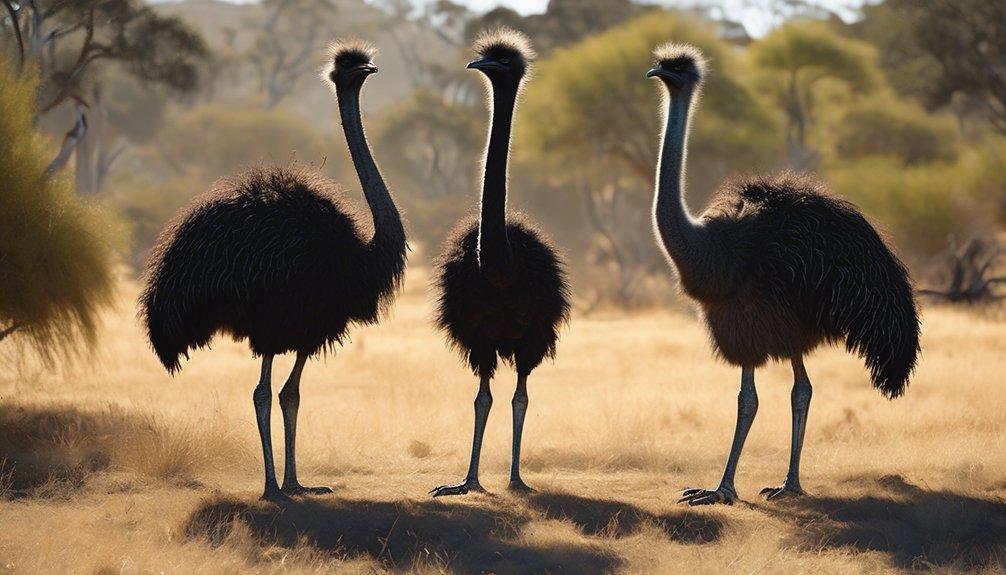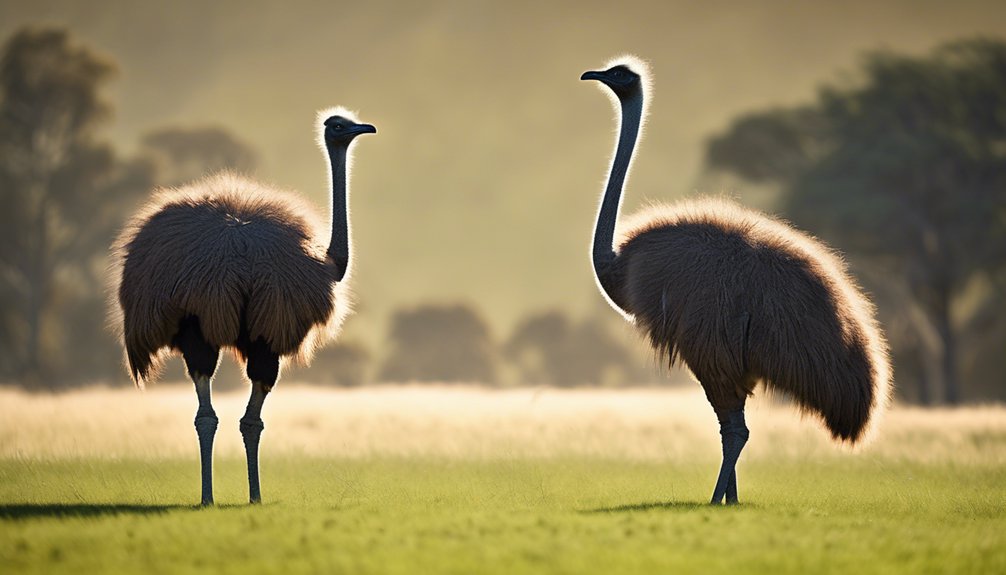
When comparing emus and ostriches, you'll notice several key differences that set these flightless birds apart. From their physical characteristics to their habitats and behaviors, each species has unique traits shaped by their environments. Understanding these distinctions can shed light on their adaptations and roles in their respective ecosystems. What other surprises might you uncover about these fascinating birds as we explore their lives further?
Key Takeaways
- Emus are native to Australia, while ostriches are found in Africa, highlighting their different habitats and geographical ranges.
- Ostriches are larger, reaching up to 9 feet tall, compared to emus, which stand about 6 feet tall.
- Emus have softer, shaggy feathers, while ostriches possess stiff, elegant black and white plumage.
- Emus are more social and often form groups, whereas ostriches tend to be solitary and territorial.
- Emu eggs are dark green, contrasting with the light brown eggs laid by ostriches in shallow depressions.
Physical Characteristics

When comparing emus and ostriches, one noticeable difference is their size. Ostriches are the largest living birds, reaching heights of up to 9 feet, while emus stand at about 6 feet tall. This significant size variation influences their physical presence and behavior.
In terms of feather patterns, emus have soft, shaggy feathers that create a unique, muted appearance, while ostriches sport long, elegant feathers that are typically black and white. These feather patterns not only enhance their visual characteristics but also serve different functions in their respective environments.
Understanding these distinctions helps you appreciate the beauty and diversity of these two remarkable birds, each adapted to their unique ecological niches.
Habitat and Distribution
While both emus and ostriches are flightless birds, their habitats and distribution reveal striking differences shaped by their evolutionary paths.
Emus primarily inhabit various landscapes across Australia, from forests to grasslands, showcasing their adaptability and diverse habitat preferences. You'll find them thriving in environments that offer ample food sources and shelter.
In contrast, ostriches are native to Africa, predominantly residing in savannas and open grasslands, where they can roam freely. Their geographical range extends across sub-Saharan Africa, reflecting their need for space and visibility.
Understanding these habitat preferences not only highlights their ecological roles but also emphasizes the importance of conservation in their respective regions, ensuring these remarkable birds continue to flourish in their natural environments.
Behavior and Social Structure

Although emus and ostriches share the trait of being flightless, their behaviors and social structures differ significantly.
Emus tend to be more social creatures, often seen in small groups that engage in complex social interactions. They communicate through a range of vocalizations, enhancing their social bonds.
In contrast, ostriches exhibit more solitary tendencies, particularly males, who can display strong territorial behaviors, especially during mating seasons.
While emus may form loose hierarchies, ostriches establish clear dominance, with aggressive displays to protect their territory.
Both species have unique approaches to social organization, shaping their interactions within their environments. Understanding these differences highlights the fascinating complexities of their behaviors and social structures, reflecting their adaptations to the challenges of their respective habitats.
Diet and Feeding Habits
The differences in behavior and social structure between emus and ostriches extend to their diets and feeding habits.
Emus primarily rely on their foraging strategies, actively searching for seeds, fruits, and insects across various terrains. Their adaptability to different environments shapes their dietary preferences, allowing them to thrive in diverse conditions.
In contrast, ostriches tend to graze on grasses and shrubs, employing a more selective feeding approach. While both birds are omnivores, emus showcase a broader palate, often consuming more plant-based materials.
Understanding these differences in dietary habits is crucial, as they reflect each species' unique adaptations and ecological niches. By appreciating their feeding behaviors, you can gain insight into how these magnificent birds navigate their worlds.
Reproduction and Nesting

When it comes to reproduction and nesting, emus and ostriches exhibit distinct behaviors that reflect their evolutionary adaptations. Emus engage in elaborate mating rituals, often involving vocalizations and displays to attract partners. In contrast, ostriches are more straightforward, with males performing simple dances to signal readiness to mate.
Both species have unique nesting habits. Emus typically build nests on the ground, while ostriches prefer to lay their eggs in shallow depressions.
Here's a quick comparison:
| Feature | Emus | Ostriches |
|---|---|---|
| Mating Rituals | Elaborate displays | Simple dances |
| Nesting Location | Ground nests | Shallow depressions |
| Egg Incubation | Male incubates | Female incubates |
| Egg Color | Dark green | Light brown |
| Clutch Size | 5-15 eggs | 5-10 eggs |
Adaptations to Environment
As these flightless birds evolved, emus and ostriches developed unique adaptations to thrive in their respective environments.
Emus, native to Australia, exhibit climatic adaptations like a feather structure that insulates against heat and helps regulate body temperature. Their long legs allow them to cover vast distances in search of food and water, a crucial survival strategy in arid regions.
Conversely, ostriches, found in Africa, have evolved to endure harsher climates with their powerful legs, enabling them to escape predators swiftly. They also possess a unique ability to tolerate extreme heat.
Both species' adaptations showcase their resilience and ingenuity, reflecting their remarkable abilities to navigate the challenges posed by their diverse habitats while ensuring their survival in the wild.
Conservation Status

Both emus and ostriches face varying degrees of conservation challenges influenced by habitat loss, hunting, and climate change. While emus are currently not classified as endangered, their populations are monitored due to potential threats. In contrast, ostriches have seen significant declines in the wild, prompting conservation efforts to protect their habitats and ensure sustainable populations.
| Species | Conservation Status |
|---|---|
| Emu | Least Concern |
| Ostrich | Vulnerable |
Conservation efforts for both species include habitat restoration, legal protection, and community engagement. By understanding these challenges, you can appreciate the importance of supporting initiatives that safeguard these remarkable birds and their ecosystems.
Cultural Significance
Emus and ostriches hold significant cultural value in various societies, reflecting their unique roles in folklore, art, and even cuisine.
In Australia, emus symbolize resilience and adaptability, often appearing in Indigenous myths and cultural traditions. They're celebrated in local art and stories, serving as a reminder of the connection between nature and identity.
Conversely, ostriches have a rich presence in African folklore, often representing speed and strength. Their feathers, highly valued, have been used in traditional attire and ceremonial objects, carrying symbolic meanings of status and beauty.
Both birds inspire a sense of pride and heritage, highlighting the importance of wildlife in cultural narratives. Understanding these associations deepens your appreciation for their roles beyond mere animals.
Comparison of Lifespan and Growth

While comparing the lifespan and growth of emus and ostriches, you'll find distinct differences that reflect their unique biological characteristics.
Emus typically live around 10 to 20 years, while ostriches boast a longer lifespan of 30 to 40 years.
When it comes to growth rates, emus reach their full size at about 6 months, weighing around 100 pounds. In contrast, ostriches take about 1 to 2 years to reach maturity, often exceeding 300 pounds.
These lifespan comparisons highlight the resilience of ostriches, adapting to various environments, while emus exhibit rapid growth suited to their habitats.
Understanding these differences not only enriches your knowledge but also deepens your appreciation for these fascinating birds.
Frequently Asked Questions
Can Emus and Ostriches Be Kept as Pets?
You can keep emus and ostriches as pets, but you must consider pet care requirements and legal considerations in your area. These birds need space, proper diets, and attention to thrive in a domestic environment.
How Fast Can Emus and Ostriches Run?
When considering running speeds, emus can reach up to 30 miles per hour, while ostriches can sprint at 45 miles per hour. Each bird utilizes unique sprinting techniques, showcasing their impressive adaptations for speed and endurance.
Are Emus and Ostriches Related to Any Other Birds?
Imagine a tree with deep roots; emus and ostriches share their evolutionary lineage with other flightless birds. In bird classification, they connect to species like kiwis and rheas, showcasing fascinating relationships in avian evolution.
What Are the Primary Threats to Emus and Ostriches?
You're looking at habitat loss and predator threats as primary risks to emus and ostriches. These factors drastically reduce their populations, pushing them into increasingly vulnerable situations, impacting their survival and ecological balance.
How Do Emus and Ostriches Communicate With Each Other?
When you observe emus and ostriches, their vocalizations comparison reveals distinct sounds. While ostriches often use low rumbles, emus prefer high-pitched calls. Both species also rely heavily on body language to convey emotions and intentions.
Conclusion
In conclusion, while emus and ostriches may seem similar as large flightless birds, their differences are striking and significant. From their physical characteristics to their behaviors and diets, each species has adapted uniquely to its environment. Coincidentally, both birds play vital roles in their ecosystems and hold cultural importance in their respective regions. Understanding these differences not only highlights their uniqueness but also emphasizes the need for conservation efforts to protect these fascinating creatures.




